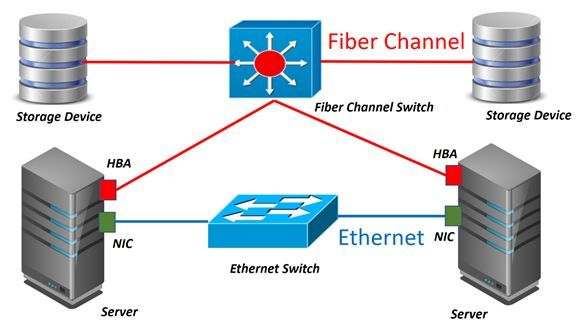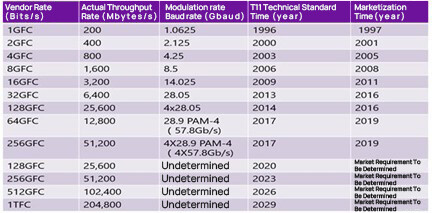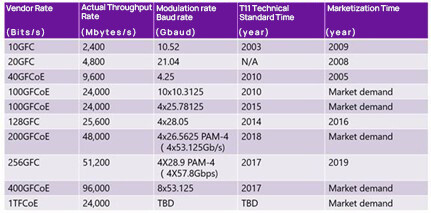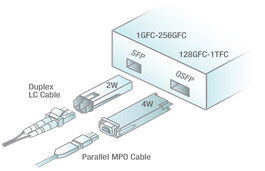Data security, data storage and data recovery are challenges that these industries must face. As an important infrastructure for data centre storage networks, fibre optic cabling systems must be able to support a minimum 15-year lifecycle.
With the advent of the All Flash Arrays storage era, higher performance requirements are being placed on fibre optic systems. In addition to ultra-low loss fibre optic systems to support higher network rates and more complex network matrices, fibre optic cabling should be designed, planned and evaluated using professional fibre optic performance calculator tools.
I. Fibre Channel Development Roadmap
A storage network is a network system dedicated to data storage and backup, which connects storage arrays (solid state drives, mechanical drives, tapes) to hosts (Unix minis, Linux servers, PC servers) via copper or optical cables. Storage networks can be divided by protocol into IP-based IP-SAN, Ethernet-based Ethernet-SAN, and Fibre Channel-based FC-SAN. FC-SAN uses "block" level storage for faster read and write speeds, higher availability and reliability, lower latency, and easier scalability. According to a 2017 market report published by the Fibre Channel Industry Association (FCIA), Fibre Channel-based storage networks currently account for 80% of the market share in the data centre market.

Figure 1: Schematic of a data centre local area network (LAN) and a Fibre Channel Storage Network (FC-SAN)
The INCITS International Committee on Information Technology Standards (INCITS) is part of the American National Standards Institute (ANSI), and the T11 Technical Committee is responsible for developing technical standards for Fibre Channel, INCITS T11 Technical Committee has released the first generation of 1G Fibre Channel (Fiber Chanel) protocols since 1997, and has been releasing new ones at an average rate of doubling every three to five years. Fibre Channel (FC) technology standards.
According to the Fibre Channel Industry Association (FCIA), a non-profit international organisation that educates and promotes the Fibre Channel market, 90% of enterprise users in the market are currently adopting fifth-generation 16GFC or sixth-generation 32GFC Fibre Channel devices, according to the Fibre Channel Industry Association's (FCIA) 2017 market study.
Fibre Channel storage networks can be divided into two parts, one is the interconnection of hosts or storage arrays and switches, and the other is the interconnection between core (Core) and edge (Edge) switches, also known as Inter-Switch Link (ISL). In summary, there are three techniques to increase network transmission rates, one is to increase the number of physical channels which is the number of fibre cores, another is to use more advanced coding methods and the third is to transmit more wavelengths on a single physical fibre.
The sixth generation 128GFC was introduced to the market in 2016 and uses parallel transmission technology, with 4 channels receiving and 4 channels transmitting at 28.05Gb/s. The seventh generation 64GFC was introduced to the market in 2019 and uses the more advanced PAM4 coding method, which enables higher speeds on the same signal carrier at 57.8Gb/s per channel, thus reducing the impact on the fibre. /s on the same signal carrier, thus reducing the need for physical cores of fibre.

Table 1: FC development roadmap
II. FCoE roadmap
The FCoE roadmap is similar to the Ethernet roadmap, with 10G FCoE for host and storage arrays and 40G FCoE for switch interconnects (ISLs), which will evolve to 25G/50G for host and storage arrays and 100G/200G/400G for ISLs in the coming years.

Table 2: FCoE development roadmap
III. Inter Switch Link Roadmap
In order to achieve non-blocking data transfer between hosts and storage arrays, the Inter Switch Link (ISL) from the Core to the Edge must use higher transfer rates. If the host and storage array uses 32GFC, the Core switch to Edge switch ISL uses 128G FC; if the host and storage array uses 64GFC, the Core switch to Edge switch ISL uses 256G FC; if the host and storage array uses 10G FCoE, the Core switch to Edge switch ISL uses 256G FC; if the host and storage array uses 10G FCoE, the Core switch to Edge switch ISL uses 256G FC. FCoE, 40G FCoE is used for Core Switch to Edge Switch Interconnect (ISL); 100G FCoE is used for Core Switch to Edge Switch Interconnect (ISL) if 25G FCoE is used for hosts and storage arrays.

Table 3: Switch Interconnect (ISL) Development Roadmap
Optical modules used for Fibre Channel
From the perspective of optical modules, 4GFC optical modules use SFP interfaces; 8GFC, 16GFC, 10G FCoE optical modules use SFP+ interfaces; 32GFC, 64GFC, 25G FCoE, 50G FCoE optical modules use SFP28 interface optical modules; SFP, SFP+, SFP28 fiber connectors use duplex LC fiber connectors. QSFP+ modules support 40G FCoE; QSFP28 modules support 100G FCoE, 128G FC; 200G FCoE and 256FGFC optical modules use QSFP56 optical modules.

Figure 7: Classification of FC optical modules